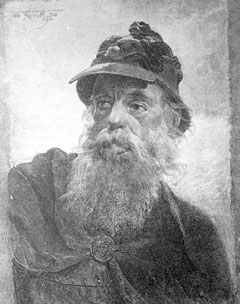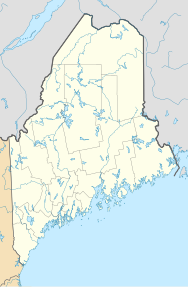
Cape Elizabeth is a town in Cumberland County, Maine, United States. The town is part of the Portland–South Portland–Biddeford, Maine, metropolitan statistical area. As of the 2020 census, Cape Elizabeth had a population of 9,535.

Castine is a town in Hancock County in eastern Maine, United States. The population was 1,320 at the 2020 census. Castine is the home of Maine Maritime Academy, a four-year institution that graduates officers and engineers for the United States Merchant Marine and marine related industries. Approximately 1000 students are enrolled. During the French colonial period, Castine was the southern tip of Acadia and served as the regional capital between 1670 and 1674.

Bristol, known from 1632 to 1765 as Pemaquid is a town in Lincoln County, Maine, United States. The population was 2,834 at the 2020 census. A fishing and resort area, Bristol includes the villages of New Harbor, Pemaquid, Round Pond, Bristol Mills and Chamberlain. It includes the Pemaquid Archeological Site, a U.S. National Historic Landmark. During the 17th and early 18th century, New France defined the Kennebec River as the southern boundary of Acadia, which put Bristol within Acadia.

Damariscotta is a town in Lincoln County, Maine, United States. The population was 2,297 at the 2020 census. Damariscotta is the oyster capital of New England. A popular tourist destination, the towns of Damariscotta and Newcastle are linked by the Main Street bridge over the Damariscotta River, forming the "Twin Villages". The name Damariscotta derives from a native place-name meaning place of abundance of small fish (alewives).

Monhegan is an island in the Gulf of Maine. A plantation, a minor civil division in the state of Maine falling between unincorporated area and a town, it is located approximately 12 nautical miles (22 km) off the mainland and is part of Lincoln County, Maine, United States. The population was 64 at the 2020 census. The plantation comprises its namesake island and the uninhabited neighboring island of Manana. The island is accessible by scheduled boat service from Boothbay Harbor, New Harbor and Port Clyde. Visitors' cars are not allowed on the island. It was designated a United States National Natural Landmark for its coastal and island flora in 1966.

South Bristol is a town in Lincoln County, Maine, United States. The population was 1,127 at the 2020 census. A fishing and resort area, South Bristol includes the villages of Walpole and Christmas Cove, the latter on Rutherford Island. The town has six nature preserves.

Kittery is a town in York County, Maine, United States. Home to the Portsmouth Naval Shipyard on Seavey's Island, Kittery includes Badger's Island, the seaside district of Kittery Point, and part of the Isles of Shoals. The southernmost town in the state, it is a tourist destination known for its many outlet stores.
The Angel Gabriel was a 240-ton English passenger galleon. She was commissioned for Sir Walter Raleigh's last expedition to America in 1617. She sank in a storm off Pemaquid Point, near the newly established town of Bristol, Maine, on 15 August 1635. The sinking occurred during a hurricane in the middle of the Great Migration.

The Harrington Meeting House is a historic colonial meeting house at 278 Harrington Road in Bristol, Maine. Built in 1772 and moved to its present site in 1775, it is one of the town's original three meeting houses. It contains a small museum of old photographs, clothing, and books. The adjoining cemetery has gravestones of historical interest. The building was added to the National Register of Historic Places as Harrington Meetinghouse in 1970.

The Pemaquid Point Light is a historic U.S. lighthouse located in Bristol, Lincoln County, Maine, at the tip of the Pemaquid Neck.

The Golden Gate National Recreation Area (GGNRA) is a U.S. National Recreation Area protecting 82,116 acres (33,231 ha) of ecologically and historically significant landscapes surrounding the San Francisco Bay Area. Much of the park is land formerly used by the United States Army. GGNRA is managed by the National Park Service and is the second-most visited unit of the National Park system in the United States, with more than 15.6 million visitors in 2022. It is also one of the largest urban parks in the world, with a size two-and-a-half times that of the consolidated city and county of San Francisco.

Colonial Pemaquid State Historic Site is a publicly owned historic property operated by the state of Maine near Pemaquid Beach in Bristol, Maine. The site includes the reconstructed Fort William Henry, archaeological remains of 17th- and 18th-century village buildings and fortifications, and a museum with artifacts found on the site including musket balls, coins, pottery, and early hardware.
Damariscove is an uninhabited island that is part of Boothbay Harbor in Lincoln County, Maine, United States, approximately 5 nautical miles (9.3 km) off the coast at the mouth of the Damariscotta River. The long, narrow island is approximately 2 miles (3.2 km) long and 1,500 feet (460 m) at its widest point. The island has served in the past as a fishing settlement and a United States Coast Guard life saving station.

Fort William Henry is located in the village of New Harbor in the town of Bristol, Maine. The fort was, in its time, the largest in New England. The fort was originally built in 1692 but destroyed four years later by New France in the Siege of Pemaquid (1696). A reconstruction was built in 1908. The fort was added to the National Register of Historic Places on December 1, 1969. Fort William Henry is now operated as a museum about the fort's history.

The siege of Pemaquid was a successful attack by a large band of Abenaki Indians on the English fort at Pemaquid, Fort Charles, then the easternmost outpost of colonial Massachusetts. The French-Abenaki attack was led by Jean-Vincent d'Abbadie de Saint-Castin and Father Louis-Pierre Thury and Chief Moxus. The fall of Pemaquid was a significant setback to the English. It pushed the frontier back to Casco (Falmouth), Maine.

The Northeast Coast campaign of 1746 was conducted by the Wabanaki Confederacy of Acadia against the New England settlements along the coast of present-day Maine below the Kennebec River, the former border of Acadia. during King George's War from July until September 1746. They attacked English settlements on the coast of present-day Maine between Berwick and St. Georges, within two months there were 9 raids - every town on the frontier had been attacked. Casco was the principal settlement.

The Northeast Coast campaign of 1747 was conducted by the Wabanaki Confederacy of Acadia against the New England settlements along the coast of present-day Maine below the Kennebec River, the former border of Acadia. during King George's War from July until September 1747. They attacked English settlements on the coast of present-day Maine between Berwick and St. Georges, within two months there were 11 raids - every town on the frontier had been attacked. Casco was the principal settlement.
Cabot Lyford was an American sculptor best known for his depictions of animals and the female figure, often using black granite and wood as materials. His sculptures are located within public parks, museums and schools throughout Maine and the United States. Some of Lyford's best known pieces includes "My Mother the Wind," which was placed on the waterfront in Portsmouth, New Hampshire, in 1975, and "Life Force," a seven-ton dolphin sculpture created from Deer Isle granite, which stands outside the Regency Hotel in Portland, Maine. Examples of his work are housed within the permanent collections of the Portland Museum of Art, the Colby College Museum of Art, the Farnsworth Art Museum, and the Ogunquit Museum of American Art in Maine.





















